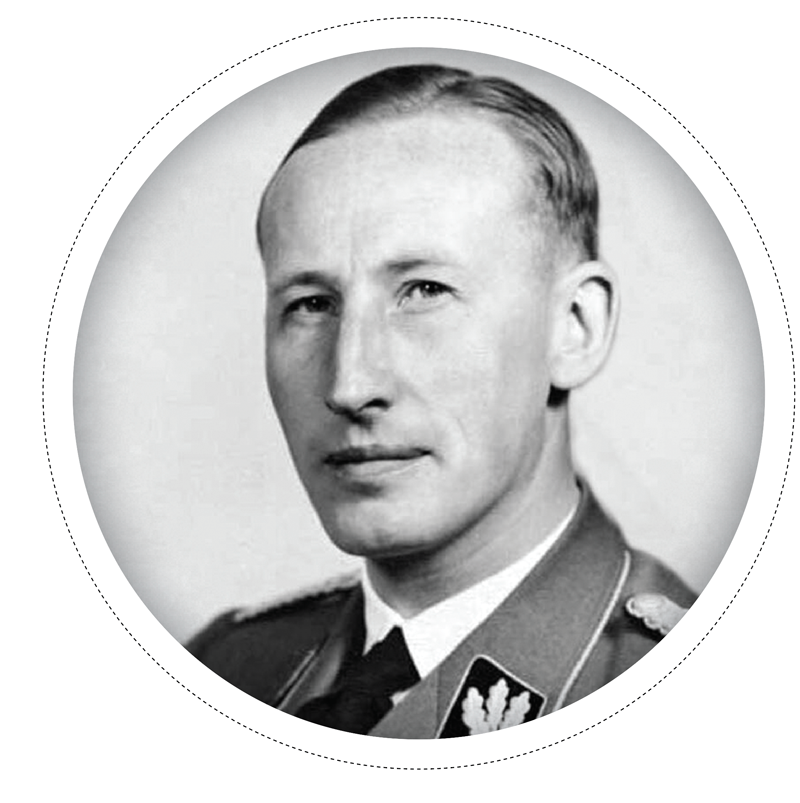Czech assasins
Two agents exact revenge on the Butcher of Prague
JOZEF GABČÍK AND JAN KUBIŠ
“I’ve been picked for a mission,” Jan Kubiš told an English couple who had befriended him and his Czechoslovak army comrade Jozef Gabčík. “I can’t tell you what…but hopefully we’re going to come back alive.”
The duo had both served in the Czech army, fled to Poland in 1939, then joined the French Foreign Legion in Algiers before coming to England in the spring of 1940. Gabčík was already at a Special Operations Executive (SOE) training centre in Arisaig, Scotland, when Kubiš left the Czech base at Cholmondeley Castle in Cheshire, England, to join him.
Their mission: to parachute into Czechoslovakia and assassinate Reinhard Heydrich, the SS Stellvertretender Reichsprotektor (acting protector) of Bohemia and Moravia, regions of the country annexed by Germany in 1939. Planning for it had begun shortly after Heydrich’s Sept. 27, 1941, appointment by Hitler to ruthlessly suppress a growing Czech resistance and ensure no disruption to the country’s vital role in supplying Germany with arms and munitions.
Czechoslovakian president-in-exile Edvard Beneš hoped Heydrich’s elimination would inspire his country and prove to the Allies that Czechs and Slovaks stood united against Germany.
Gabčík and Kubiš are considered heroes in their homelands.
On Dec. 28, 1941, Gabčík and Kubiš parachuted from a Royal Air Force Halifax bomber near Prague. Once on the ground, the duo contacted local resistance groups in the city and refined their plan. Resistance leaders expressed fear that the operation—codenamed Anthropoid—would lead to brutal reprisals, but Beneš dismissed their concerns.
Heydrich moved freely about Prague in an open-top Mercedes-Benz convertible following predictable routes. On May 27, 1942, Gabčík and Kubiš deployed next to a tram stop where a tight corner forced Heydrich’s car to slow down. As the car turned, Gabčík tried to fire his Sten submachine gun. But it jammed. Seeing the assassins, Heydrich ordered his driver to stop and engaged them with a Luger pistol. Kubiš seized the moment, rolling a British Type No. 73 anti-tank grenade under the car. The explosion peppered Kubiš’ face with shrapnel, but also severely wounded Heydrich, who later died of complications arising from the attack.
The assassins escaped, eventually joining a small resistance group inside Saints Cyril and Methodious Cathedral. It was overrun on June 18 by the
Waffen-SS searching for the pair. Gabčík died by suicide and Kubiš died of wounds suffered during the two-hour gun battle. Heydrich’s assassination remains controversial, but Gabčík and Kubiš are considered heroes in their homelands.
Heydrich

[wikimedia]
REINHARD HEYDRICH
Before Reinhard Heydrich became the governor of Bohemia and Moravia in Czechoslovakia (modern-day Czech Republic), the SS general played a crucial role in implementing the elimination of Jews and other perceived threats to the Nazi state. Alongside SS Reichsführer Heinrich Himmler, he opened the Dachau concentration camp in 1933. On Jan. 24, 1939, key Hitler confidant Hermann Göring assigned Heydrich to oversee the Central Office for Jewish Emigration, which aimed to force Jews to leave the Reich by any means necessary. And two years later, Göring ordered Heydrich to plan details of the “Final Solution.” During the Wannsee Conference on Jan. 20, 1942, Heydrich promised, “Europe would be combed of Jews from east to west.”
Born near Leipzig, Germany, on March 7, 1904, Heydrich embraced racist movements as a teenager before joining the German navy. Dishonourably discharged following a romantic affair, Heydrich joined the SS. With resistance in Bohemia and Moravia growing, Heydrich was appointed to suppress it. Dubbed the “Butcher of Prague,” Heydrich initially used special courts to sentence hundreds of people to death and turn more than 1,000 more over to the Gestapo. He then established Theresienstadt Ghetto, a way station through which nearly 90,000 Jews were deported to other ghettos and ultimately to concentration camps. By March 1942, Heydrich oversaw the purging of thousands of people from cultural, patriotic, military or intellectual organizations. “We will Germanize the Czech vermin,” he declared.
Heydrich planned details of the “Final Solution.”
It was this extensive repression that convinced president-in-exile Edvard Beneš to have Heydrich assassinated. The attack was enabled by Heydrich’s hubris. He insisted on travelling without bodyguards in an open car along routine routes. The explosion seriously injured the left side of Heydrich’s body, damaging his diaphragm, spleen, lung and fracturing a rib. Staggering from the car, Heydrich initially appeared only dazed. He returned fire and pursued Gabčík before collapsing.
After eight days in hospital and seemingly recovering, Heydrich lapsed into a coma and succumbed to septicemia. Following his death, massive reprisals resulted in the murder of thousands. False leads on the whereabouts of his attackers prompted destruction of the Czechoslovakian village of Lidice, where nearly 200 men were killed, about 200 women were deported to the Ravensbrück concentration camp and 95 children were taken prisoner; most were later murdered. The village of Ležáky suffered a similar fate. It too was destroyed, and all adult residents killed. After Heydrich’s death, Hitler praised him as “one of the staunchest defenders of the…German Reich and one of the greatest opponents of all enemies of this Reich.”
Advertisement























